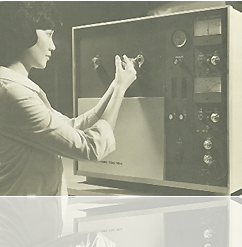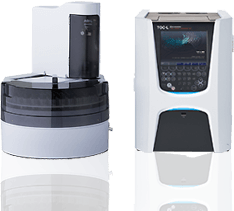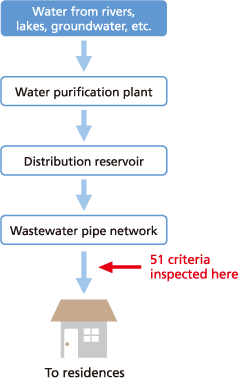

TOC Academy

Water Quality Inspections for Public Drinking Water
Public drinking water is supplied by using a water treatment based on the water quality of the given river, lake, groundwater, or other water source. However, the water quality of public drinking water can vary due to changes in the water quality or usage rate of the river or lake.
Therefore, it is important to regularly inspect the safety of treated water.
In Japan, the Water Supply Act specifies water quality standards by law.
Japan’s Water Supply Act
In essence, the purpose of the Water Supply Act is to improve the lives of Japan’s citizens by creating public water supply systems throughout Japan that can cheaply deliver large quantities of clean water. However, what does “clean water” really mean?
To address that question, the Water Supply Act specifies water quality standards. Those water quality standards specify 51 types of inspection criteria, with water system contractors regularly inspecting public water systems to make sure public water supplies satisfy those criteria. That means only safe drinking water that passes those strict inspection standards is delivered to homes.
Inspecting Water Quality

Water from rivers or lakes is treated and supplied from the faucets in our homes as public drinking water according to the process illustrated above.
The fact that the 51 types of inspection criteria specified by the Water Supply Act are checked immediately prior to delivery to our homes indicates their importance.
Supplying Water that is Both Safe and Good-Tasting
Furthermore, in Japan, due to the increasing consumption of bottled mineral water, increasingly widespread use of residential water purification systems, and other factors, there is growing interest in water that is not only safe but also good-tasting.
Given such circumstances, to supply safe and good-tasting water, some prefectures have specified water quality goals for the taste of water that are separate from the inspection standards for the 51 criteria specified by the Water Supply Act.
| Inspection Parameter | Description |
|---|---|
| Evaporation Residues | The residues that remain after water is evaporated mainly consist of minerals. Water that contains large amounts of such minerals can taste bitter or astringent, whereas water that contains moderate amounts tend to have a smooth rich taste. |
| Hardness | Hardness indicates the calcium or magnesium content, which are the main mineral components in water. An appropriate level of hardness components is a requirement for good-tasting water. Water with low hardness is referred to as “soft” water and has no distinctive flavor. In contrast, water with high hardness is referred to as “hard” water and has a more persistent flavor, which some people prefer but some do not like. |
| Free Carbon Dioxide | In water, free carbon dioxide refers to dissolved carbon dioxide gas that gives water a crisp sensation, but too much can be overstimulating and reduces smoothness. |
| Potassium Permanganate Consumption | This is an index for organic matter in water. Higher concentrations can result in a bitter taste. |
| Odor Intensity | This indicates the intensity level of odors in water (regardless of the odor type). Moldy odors, algae odors, or other unpleasant odors from water can make water taste bad. |
| Residual Chlorine | This refers to residues of chlorine used to disinfect public drinking water. For public health reasons, public drinking water is required to contain at least 0.1 gm/L of residual chlorine, but if the residual chlorine concentration is too high, it can cause a chlorine bleach odor. |
| Water Temperature | Cold water physiologically tastes better. In addition, chlorine and other odors are less noticeable in cold water, which makes the water taste better. |
The water treatment and water quality inspection practices described above have resulted in Japan being one of the few countries in the world with tap water that is safe to drink. However, achieving that requires sophisticated technology and high costs. For countries with a small land area, like Japan, it can be relatively easy to build the infrastructure, but for countries with large land areas, infrastructure can require massive amounts of time and expense. Many developing countries have regions without access to public water supply systems.
Even in Japan, if rivers, lakes, and other sources for public water systems become more polluted, the current water treatment infrastructure may not be adequate for ensuring safe and good-tasting water. Therefore, it is important to value safe and good-tasting water as something precious, rather than taking it for granted.


